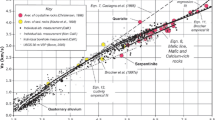Abstract
In order to investigate the effect of lateral errors on the sounding curves and subsequently their reduction, a site where considerable amount of inhomogeneities were thought to exist because of the excavations made during the building work previously carried out was chosen as a study area. Using the tripotential system of sounding promoted by Carpenter and Habberjam (Geophysics 21: 455-469, 1956), several soundings were performed. For some small electrode spacings, the three apparent resistivity curves were locally divergent indicating the existence of small-scale lateral errors; in other cases, these curves cross each other indicating the existence of additional observational errors. Some soundings showed continuous divergence of the three apparent resistivity curves as an indication of the existence of a major lateral discontinuity. Because of the interference of these disturbing effects, the interpretation of the soundings based on a horizontally layered earth is erroneous. One of these soundings containing these kinds of errors is taken as example. In order to reduce the effect of local inhomogeneities, an approach based on the linear filtering technique is suggested. As a check of the effectiveness of this method, the recalculated values of the two lateral error tests suggested by the authors were reduced when the three smoothed apparent resistivity curves were used. However, this method seemed more suitable for a flat trend data than for a data with a trend.










Similar content being viewed by others
References
Abdullahi NK, Batu MA (2012) Fracture determination using azimuthal Schlumberger and offset Wenner array in basement complex of western Nigeria. Research Journal of environmental and earth science 4(7):747–755
Acworth RI, Griffiths DH (1985) Simple data processing of tripotential resistivity measurements as an aid to the interpretation of subsurface structure. Geophys Prospect 3:861–887
Barker RD (1979) Signal contribution sections and their use in resistivity studies. Geophys. J.R. astr. Soc 59:123–129
Barker RD (1981) The offset Wenner system of electrical resistivity sounding and its use with a multicore cable. Geophys Prospect 29:128–143
Bendat JS, Piersol AG (1978) Measurement and analysis of random data. John Wiley- interscience Publication, New York
Bingham C, Godfrey M D, Tukey J W (1967) Modern techniques of power spectrum estimation. I.E.E.E. Transactions on audio and electro-acoustic Vol. AU- 15, No. 2
Carpenter EW, Habberjam GM (1956) A tripotential method of resistivity prospecting. Geophysics 21:455–469
Greve AK, Acworth IA (2010) Detection of subsurface soil cracks by vertical anisotropy profiles of apparent electrical resistivity. Geophysics 75(4):WA85–WA93
Habberjam GM, Watkins GE (1967) The use of the square configuration in resistivity prospecting. Geophys Prospect 15:221–235
Hassan AA (2013) Effect of soil cracking on 2 D electrical resistivity measurements. International Journal of Science and Research 4:2981–2984
Hobbs BA, Reading AM (1994) Shallow fault location in coal measures using offset Wenner resistivity profiling. Geophys Prospect 42:343–356
Kanasewich ER (1973) Time sequence analysis in geophysics. The university of Alberta press, Alberta
Merrick N P (1974) The pole-multidipole method of geoelectrical sounding. Exploration Geophysics 5(2), p 48
Michael G A, Agwul A A (2014) DC resitivity investigation of anisotropy and lateral effect using azimuthal offset Wenner array. A case study of the University of Calabar, Nigeria. Journal of environmental and earth science 4(1): 53:60
Morris M, Ronning J S (1993) Detecting lateral resistivity inhomogeneities with the Schlumberger array. Extended abstract of 55 the EAEG meeting, Stavanger, Norway
Nazerali N A, Coles D A, Minsley B, Mukhopadhyay A, Al-Ruwaih, Morgan F D (2015) Effects of lateral heterogeneity on 1D D.C resistivity and transient electromagnetic soundings in Kuwait. SEG Technical Program Expanded Abstracts pp 4989–4993
Otnes KR, Enochson L (1978) Applied time series analysis. John Wiley – interscience Publication, New York
Tang M (1985) Reduction of the effects of lateral resistivity variations in Schlumberger Geosounding. Warsaw University, Department of Geology, Institute of Hydrogeology and Engineering Geology 139 Pages
Author information
Authors and Affiliations
Corresponding author
Additional information
This article is part of the Topical Collection on Current Advances in Geology of North Africa
Rights and permissions
About this article
Cite this article
Chermali, M., Bounif, M.O. & Boudella, A. Detection of errors with the Tripotential array and their reduction by a filtering technique. Arab J Geosci 10, 353 (2017). https://doi.org/10.1007/s12517-017-3136-4
Received:
Accepted:
Published:
DOI: https://doi.org/10.1007/s12517-017-3136-4




